What better occasion for a Serie A mailbag than in the middle of a forced break of the five major European leagues (and of most sports)? We won't see much, if any, football played for quite some time; there is no plan that covers a scenario like COVID-19, and so we don't even know when it will return. This is the first time in Italy that football has stopped due to a health crisis. In 1973, despite the cholera epidemic, football continued its season. The only tournament in history that never finished was back in 1915, when the championship was suspended due to the war. In 1919 the title was awarded to Genoa, but the documents of the time were lost, so why this occurred cannot be officially established. So without football to watch, we'll take this opportunity to answer your questions. You can continue to send me questions on Twitter or to my email.
Have you ever written an article about players playing poorly or underachieving? (from Zach)
In fact, two Serie A players started the season with very high expectations that they were unable to live up to, and those expectations may have been based on biased performance evaluations. Simone Verdi arrived in Turin as the most expensive purchase in Torino history. The attacker came from Napoli on a €3 million loan with a €20 million obligation to buy, plus another €2 million possible in bonuses. Torino and Sampdoria fought over Verdi, which probably pushed the price up, yet the strange thing was he'd had a rather poor season. He played just 8.6 90s in his only year in Naples, and missed12 games due to injury. That makes it difficult to justify a price of around 10 million higher than what Napoli paid Bologna. 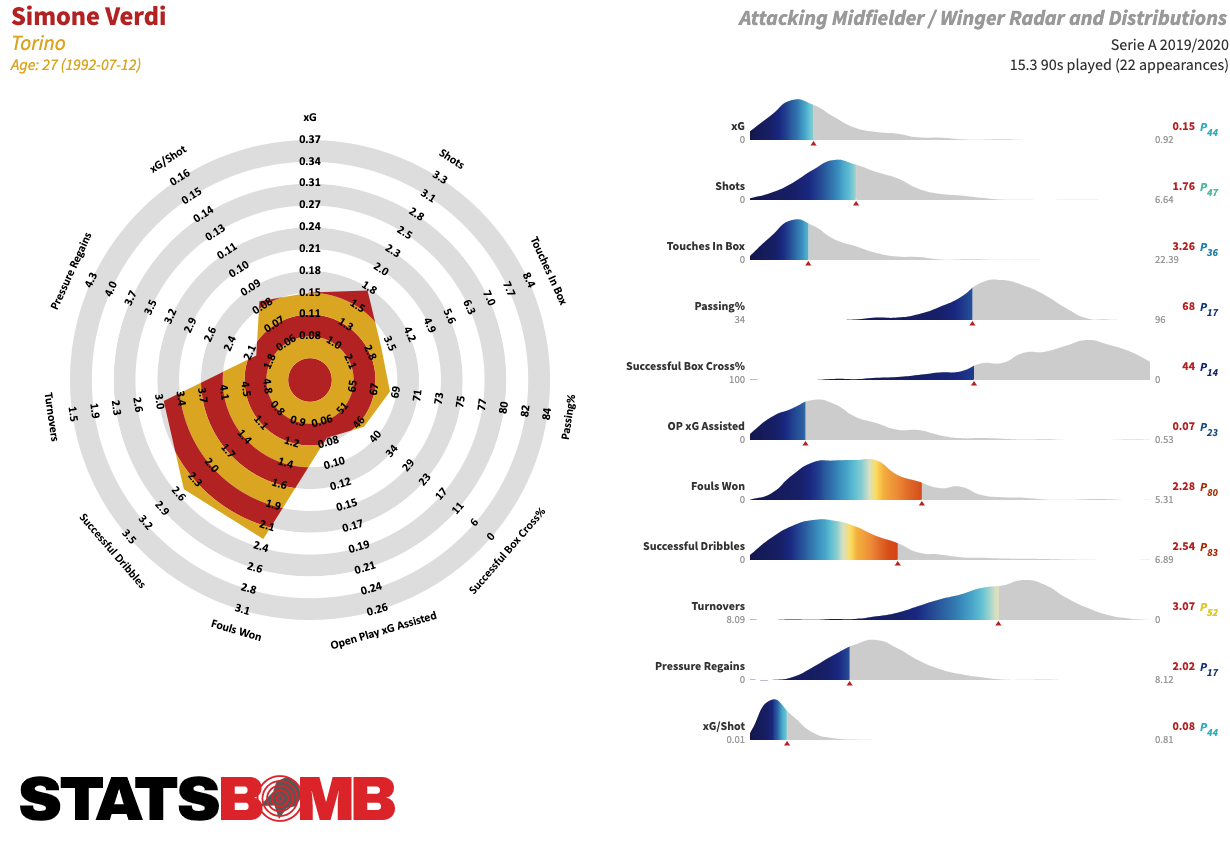 Despite limited playing time under Carlo Ancelotti he scored three goals, including one against Torino, but probably the club's decision was likely not based on that goal but rather on his 2017–18 season with Bologna. There, Verdi seemed fantastic, scoring 10 goals and 10 assists. But two of those goals were from penalties and three from direct free kicks, while seven of his assists came from crosses and four from free kicks or corners. This creates an overall scoring contribution of 0.63 goals+assists per 90, yet his open play contribution was just 0.35 — still good for a winger, but not as impressive. The other misunderstanding lies in his role on the pitch. At Bologna, Verdi proved himself to be a winger equally skilled with both feet and one who could play on both sides of the pitch. Ancelotti also played him on either flank, but under Walter Mazzari he is used as one of the attacking midfielders in a 3-4-2-1, a role not particularly suited to a player accustomed to starting out wide and dribble inside, or to delivering crosses from out wide. In his only match under new coach Moreno Longo, he played at right wing in a 3-4-3 and scored his team's only goal. When the league resumes, that's where he'll need to start if Torino want to put their investment to good use. My other choice may seem surprising, but in my opinion, he's offering much less than he could and far less than the club paid. This summer, Cagliari spent a record-setting €16.9 million to bring in midfielder Nahitan Nández from Boca Juniors.
Despite limited playing time under Carlo Ancelotti he scored three goals, including one against Torino, but probably the club's decision was likely not based on that goal but rather on his 2017–18 season with Bologna. There, Verdi seemed fantastic, scoring 10 goals and 10 assists. But two of those goals were from penalties and three from direct free kicks, while seven of his assists came from crosses and four from free kicks or corners. This creates an overall scoring contribution of 0.63 goals+assists per 90, yet his open play contribution was just 0.35 — still good for a winger, but not as impressive. The other misunderstanding lies in his role on the pitch. At Bologna, Verdi proved himself to be a winger equally skilled with both feet and one who could play on both sides of the pitch. Ancelotti also played him on either flank, but under Walter Mazzari he is used as one of the attacking midfielders in a 3-4-2-1, a role not particularly suited to a player accustomed to starting out wide and dribble inside, or to delivering crosses from out wide. In his only match under new coach Moreno Longo, he played at right wing in a 3-4-3 and scored his team's only goal. When the league resumes, that's where he'll need to start if Torino want to put their investment to good use. My other choice may seem surprising, but in my opinion, he's offering much less than he could and far less than the club paid. This summer, Cagliari spent a record-setting €16.9 million to bring in midfielder Nahitan Nández from Boca Juniors. 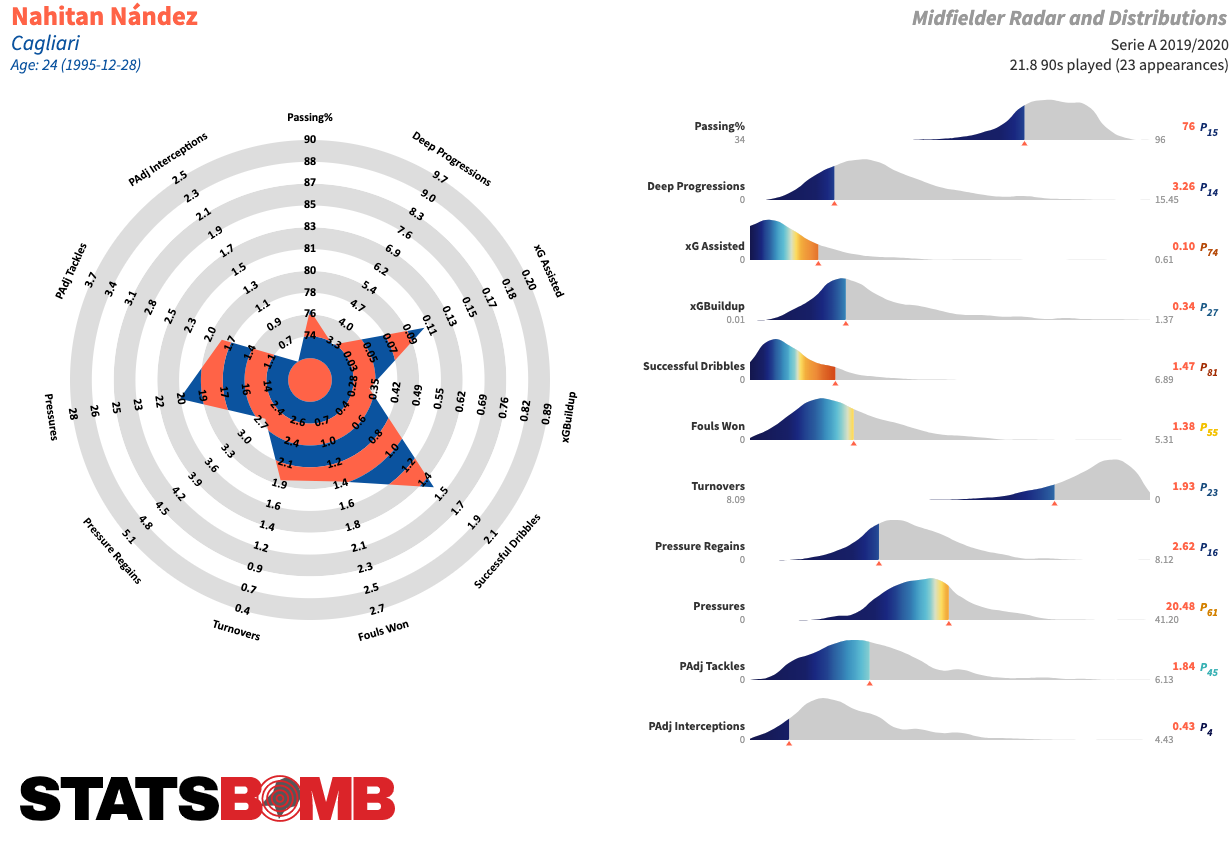 Nández's performance may be biased by his team's overperformance in the first part of the season, yet in neither the 13-game undefeated streak that lasted until December, nor in the current streak of 11 games without a win — which marked Cagliari's inescapable regression toward the mean and led to the sacking of coach Rolando Maran — has he impressed me, and the numbers back me up. Sure, some of his plays are flashy and his tackles imperious, but he lacks consistency.
Nández's performance may be biased by his team's overperformance in the first part of the season, yet in neither the 13-game undefeated streak that lasted until December, nor in the current streak of 11 games without a win — which marked Cagliari's inescapable regression toward the mean and led to the sacking of coach Rolando Maran — has he impressed me, and the numbers back me up. Sure, some of his plays are flashy and his tackles imperious, but he lacks consistency. 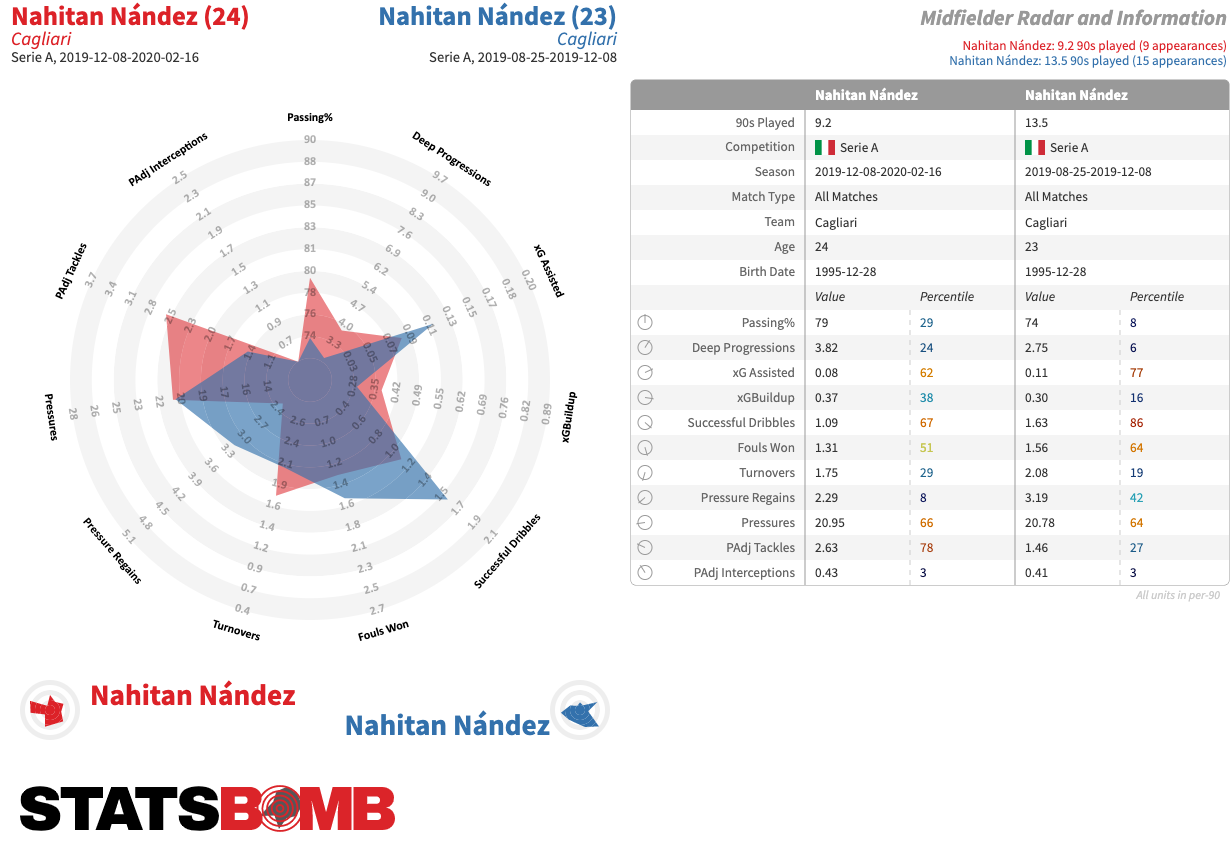 Even in Cagliari's 4-3-2-1, which utilizes direct play and transitions, he misses too many passes — the worst among midfielders — and his risk/reward balance is quite unfavorable, as his contribution to xG build-up and the number of his deep progressions is marginal when compared to his teammates. He's a decent tackler, but he rarely intercepts the ball and his rough tackles+interceptions numbers (2.6 per 90) are almost half the amount (4.8 per 90) of the other number 8, Marko Rog (who in all fairness is dribbled past more easily). Nández is probably a better player than he has shown at Cagliari, but nothing in the numbers supports the potential €40 million supposedly offered for him in January. If the rumors were true, the club would've been wise to accept.
Even in Cagliari's 4-3-2-1, which utilizes direct play and transitions, he misses too many passes — the worst among midfielders — and his risk/reward balance is quite unfavorable, as his contribution to xG build-up and the number of his deep progressions is marginal when compared to his teammates. He's a decent tackler, but he rarely intercepts the ball and his rough tackles+interceptions numbers (2.6 per 90) are almost half the amount (4.8 per 90) of the other number 8, Marko Rog (who in all fairness is dribbled past more easily). Nández is probably a better player than he has shown at Cagliari, but nothing in the numbers supports the potential €40 million supposedly offered for him in January. If the rumors were true, the club would've been wise to accept.
Dejan Kulusevski at Juventus
https://twitter.com/FootballSthlm/status/1237513472579006464 This is not an easy question to answer because no one's really quite worked out what Maurizio Sarri's Juventus is. The coach himself delivered several alarming statements throughout the season, pointing out that the Bianconeri players have different qualities to those he coached at Napoli, implying he could not achieve the same quality of play and explaining the effort he's making to convey to his squad the concept of moving the ball faster. On the other hand, we are beginning to understand what kind of player Dejan Kulusevski is. As I previously wrote, his mix of size, speed, size, creativity and athleticism is hard to find, especially in such a young player. 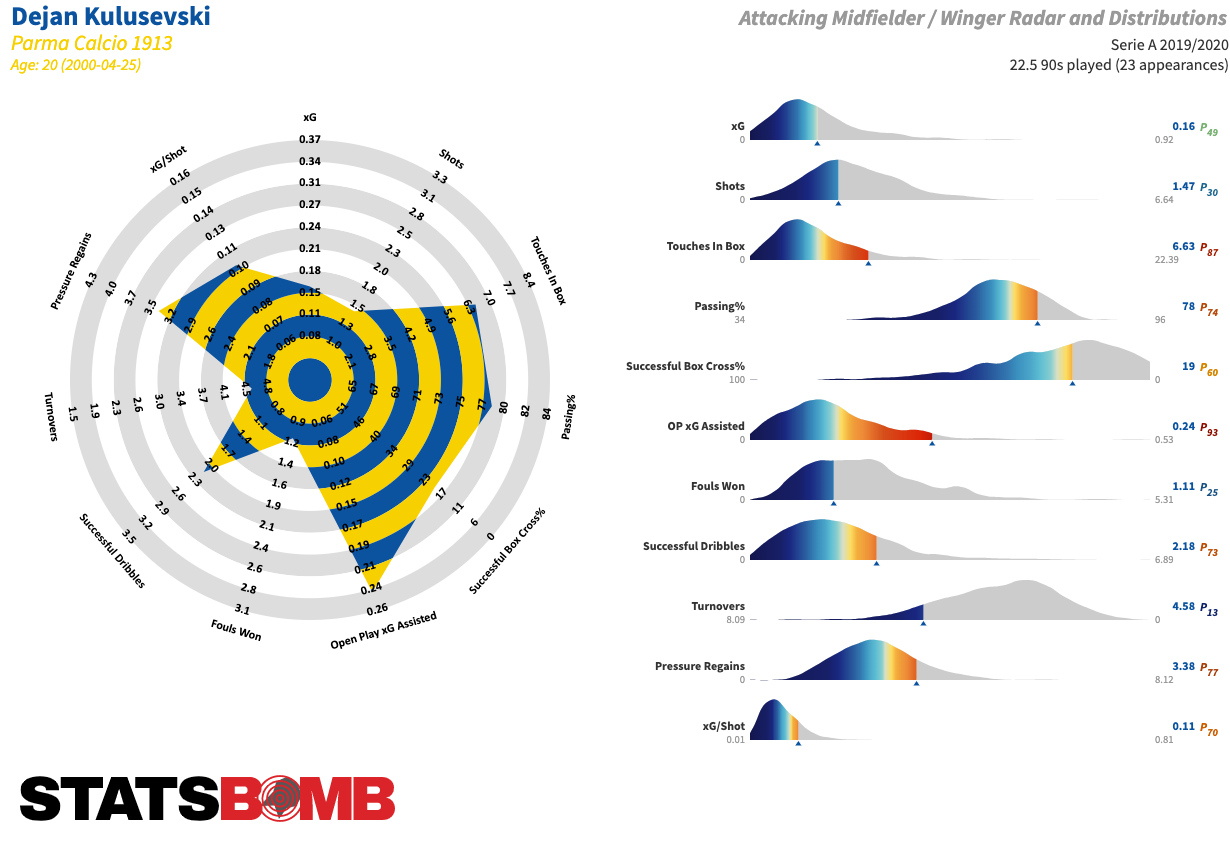 He currently plays in a team unique in the league because of the speed at which they play. Parma has the highest value of pace toward goal in Serie A, with an average speed of buildup of 3.10 metres per second of 3.10. So he's used to playing the ball fast as Sarri would like his players to, even though his current coach Roberto D’Aversa's tactics are much different. At Juventus, Dejan Kulusevski could play wide on the right to complete a three-man attack with Cristiano Ronaldo on the left and one of Gonzalo Higuaín or Paulo Dybala in the middle. He doesn’t take a lot of shots as he's more of a pass-first player, which could help him bring space into an attack that includes a center-forward and a shot-monster like Ronaldo on the opposite side. Dejan Kulusevski is perhaps more effective when he moves inside to look for the decisive pass than when he dribbles down the line. He currently averages 0.24 xG assisted per 90, a figure higher than any Juventus player. Therefore, Sarri could play him as the offensive midfielder in a 4-3-1-2, where he often fielded Federico Bernardeschi at the beginning of the season.
He currently plays in a team unique in the league because of the speed at which they play. Parma has the highest value of pace toward goal in Serie A, with an average speed of buildup of 3.10 metres per second of 3.10. So he's used to playing the ball fast as Sarri would like his players to, even though his current coach Roberto D’Aversa's tactics are much different. At Juventus, Dejan Kulusevski could play wide on the right to complete a three-man attack with Cristiano Ronaldo on the left and one of Gonzalo Higuaín or Paulo Dybala in the middle. He doesn’t take a lot of shots as he's more of a pass-first player, which could help him bring space into an attack that includes a center-forward and a shot-monster like Ronaldo on the opposite side. Dejan Kulusevski is perhaps more effective when he moves inside to look for the decisive pass than when he dribbles down the line. He currently averages 0.24 xG assisted per 90, a figure higher than any Juventus player. Therefore, Sarri could play him as the offensive midfielder in a 4-3-1-2, where he often fielded Federico Bernardeschi at the beginning of the season. 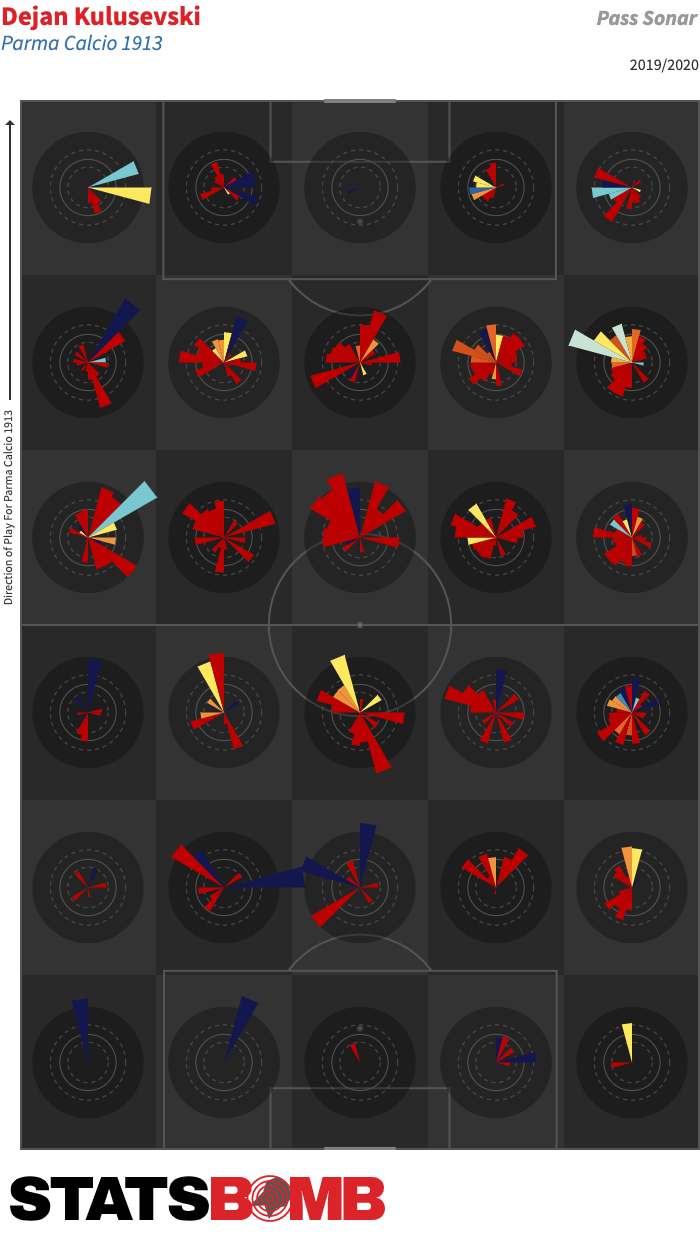 Kulusevski is also very clever when entering the penalty area (as shown by his number of touches in the box), a fundamental characteristic for Juventus, who this season averages fewer than two players in the penalty area when shooting, which is also due to how rarely their number 8s not named Aaron Ramsey tend to push forward. Moving from Parma to Juventus will be a huge step, but Kulusevski's talent is unquestionable. While Sarri will need to gradually integrate him into the side, he could help solve some of Juventus’ offensive issues.
Kulusevski is also very clever when entering the penalty area (as shown by his number of touches in the box), a fundamental characteristic for Juventus, who this season averages fewer than two players in the penalty area when shooting, which is also due to how rarely their number 8s not named Aaron Ramsey tend to push forward. Moving from Parma to Juventus will be a huge step, but Kulusevski's talent is unquestionable. While Sarri will need to gradually integrate him into the side, he could help solve some of Juventus’ offensive issues.
Could Genoa stay up?
https://twitter.com/Tacche9/status/1231932913580728320 In terms of results, Genoa have been one of the worst teams this season. Last year the Rossoblu finished with the same number of points as Empoli, who were relegated, but managed to survive on the final day. This season they are again in a similar situation. Despite being one of the 12 teams to have played 26 games, they are fourth from bottom, with the same points of Lecce who are in the relegation zone. Their situation is even worse than last year as they are 5th from the bottom in non-penalty goal difference (-0.41 xG on average) while last season they managed -0.20 xG per game, a respectable 12th in the league. However, Genoa's situation has improved after bringing in Davide Nicola, their third coach, each of which oversaw 9 games. The former coach of Crotone is literally saving the season, with a 9-game average of 1.55 points, compared to that of 0.66 under first-time professional coach Thiago Motta and 0.62 of Aurelio Andreazzoli, who started the season on the bench of the team that the season before had condemned him to relegation with Empoli.  Andreazzoli, and especially Thiago Motta, attempted a proactive approach, which perhaps needed more time to bring the hoped-for results. But Genoa couldn’t buy time and so bet on the more pragmatic Nicola, who had already saved Crotone from relegation in 2017–18. Nicola has accelerated the lethargic pace of Thiago Motta's team, who was dead last for pace to goal at 1.70 m/s, to 2.96 m/s, also higher than Andreazzoli's 2.17 m/s. He also cut the number of passes needed to consolidate possession that had made Genoa vulnerable to opposition pressing. Since his arrival, Genoa have conceded 3.33 high-press shots on average, while his predecessors were both above 4. In the defensive phase, there's not a particularly low defensive distance, but in return, PPDA has climbed to 10.34, a sign that the team is pressing with less intensity. Andreazzoli maintained an average of 8.23, and Thiago Motta, 8.77.
Andreazzoli, and especially Thiago Motta, attempted a proactive approach, which perhaps needed more time to bring the hoped-for results. But Genoa couldn’t buy time and so bet on the more pragmatic Nicola, who had already saved Crotone from relegation in 2017–18. Nicola has accelerated the lethargic pace of Thiago Motta's team, who was dead last for pace to goal at 1.70 m/s, to 2.96 m/s, also higher than Andreazzoli's 2.17 m/s. He also cut the number of passes needed to consolidate possession that had made Genoa vulnerable to opposition pressing. Since his arrival, Genoa have conceded 3.33 high-press shots on average, while his predecessors were both above 4. In the defensive phase, there's not a particularly low defensive distance, but in return, PPDA has climbed to 10.34, a sign that the team is pressing with less intensity. Andreazzoli maintained an average of 8.23, and Thiago Motta, 8.77. 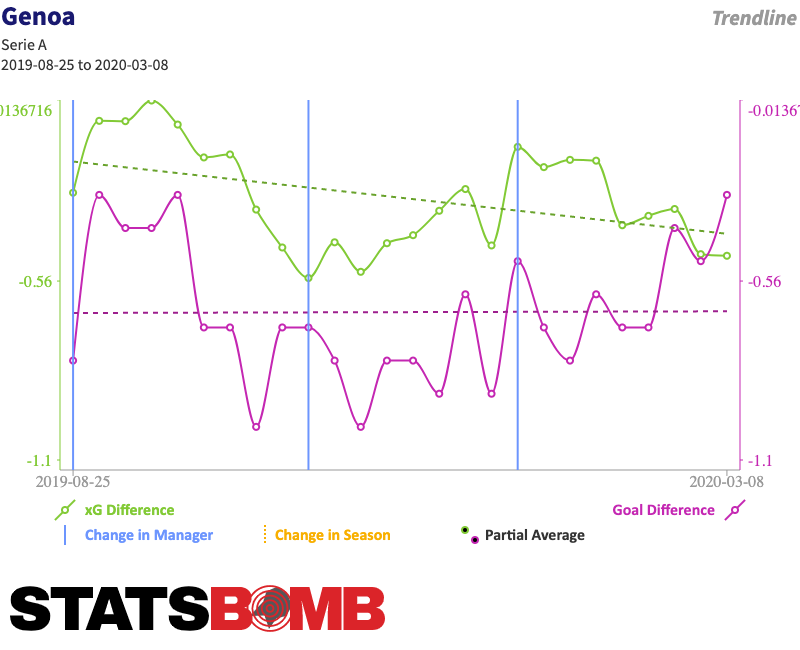 While the change of style appears more productive, the underlying numbers are not exactly positive. Nicola's Genoa is still above 15 shots conceded per game but have dropped to 10 shots made on average. Their xG per shot has improved to 0.12 (it was 0.08 under both Andreazzoli and Thiago Motta) while xG per shot conceded also decreased (0.10). Overall, there is no significant change in the non-penalty xG difference trend. But with Nicola, Genoa have finally started to reap what they have sown, as evident from the convergence between non-penalty xG difference and non-penalty goal difference. If they continue like this, they could once again avoid relegation, when and if the season starts again.
While the change of style appears more productive, the underlying numbers are not exactly positive. Nicola's Genoa is still above 15 shots conceded per game but have dropped to 10 shots made on average. Their xG per shot has improved to 0.12 (it was 0.08 under both Andreazzoli and Thiago Motta) while xG per shot conceded also decreased (0.10). Overall, there is no significant change in the non-penalty xG difference trend. But with Nicola, Genoa have finally started to reap what they have sown, as evident from the convergence between non-penalty xG difference and non-penalty goal difference. If they continue like this, they could once again avoid relegation, when and if the season starts again.